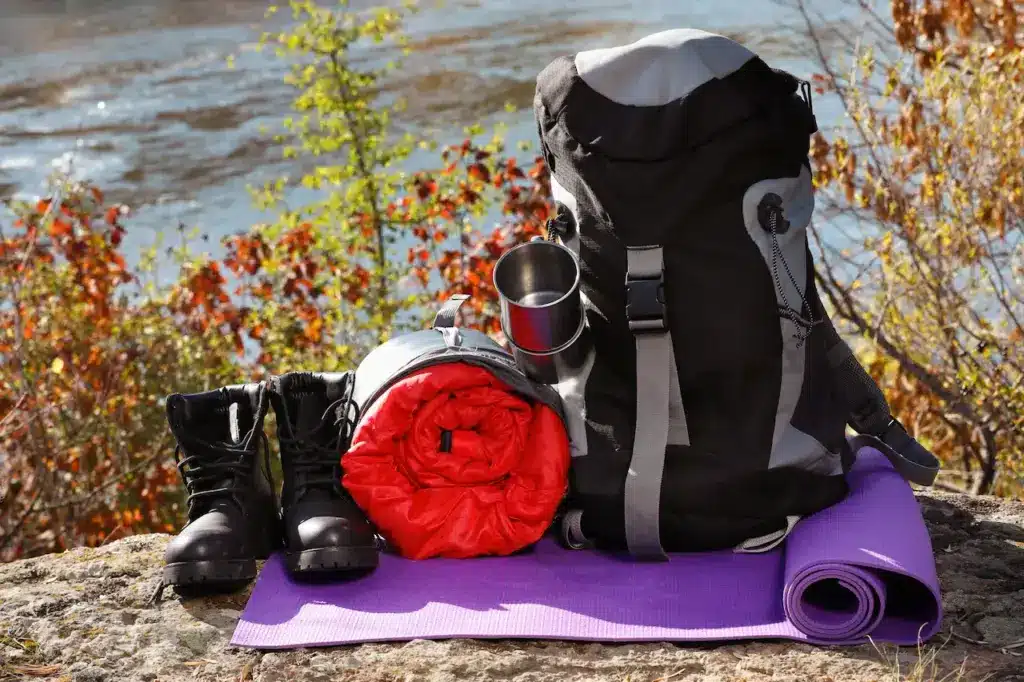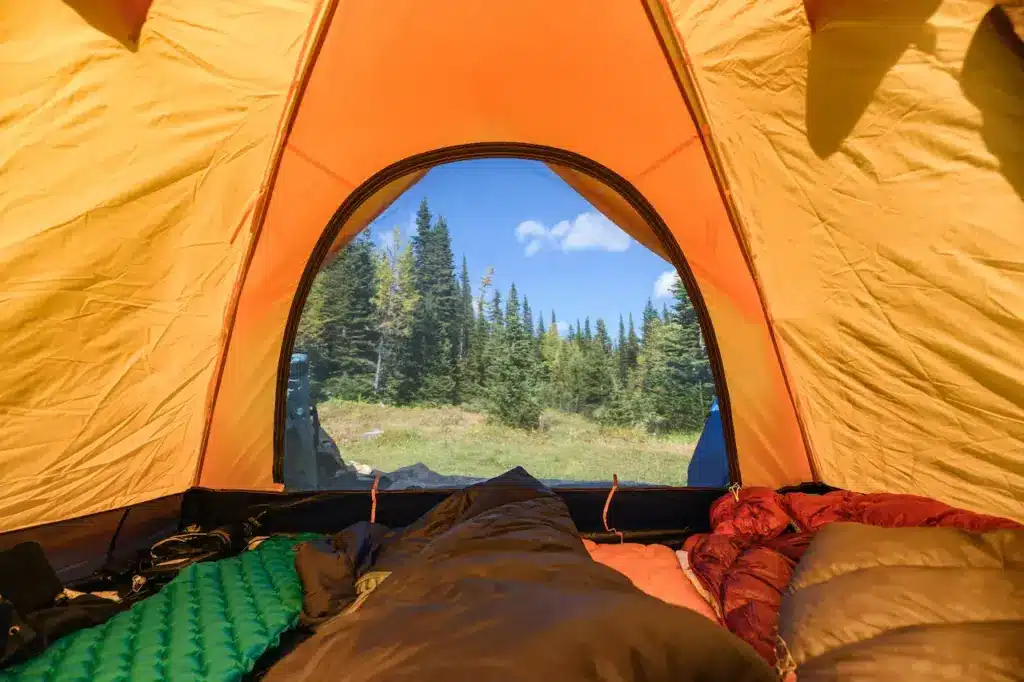Sleeping bags are an essential piece of gear for any camping or backpacking trip. They provide warmth and comfort, allowing you to get a good night’s sleep in the outdoors. When it’s time to pack up camp, a common question is whether you should roll or stuff your sleeping bag. Both methods allow you to compress the bag down to a smaller size to fit in your backpack. However, there are advantages and disadvantages to each technique.
Stuffing a sleeping bag leads to better compression and saves more space in your pack. Sleeping bags with down insulation are easily damaged when rolled too tightly. Stuffing avoids this issue. Rolled-up sleeping bags take up more room externally on a backpack. However, rolling sleeping bags make them easier to attach to the exterior of a pack if needed.

So, should you roll or stuff your sleeping bag? Below, we’ll compare the two methods and see when each works best. We’ll also cover proper techniques for stuffing sleeping bags to maximize compression. Tips for long-term storage are also included. Let’s dive in!
Roll or Stuff a Sleeping Bag (And Why Stuffing Is Better)
When to Roll a Sleeping Bag
Rolling a sleeping bag into a tight cylinder used to be the default method of packing them up. It’s a straightforward technique that keeps the bag contained and protected. Sleeping bags with synthetic insulation can be rolled up tightly without damage. Roll stuff sacks with straps are designed to facilitate rolling and compression.
Rolling works well when you need to attach the sleeping bag externally to a pack. The cylindrical shape hugs the backpack frame neatly. Skinny rolled-up sleeping bags can also be wedged into open crevices in a pack if space is limited inside.
Disadvantages of Rolling Sleeping Bags
While effective, rolling up sleeping bags has some downsides:
- Takes up more space – Rolling compresses a sleeping bag but leaves more dead space than stuffing does. Rolls are bulkier and less efficient in terms of using pack space.
- Can damage down insulation – Excessive compression from tight rolling can ruin delicate down insulation inside a sleeping bag. It exposes the down to prolonged pressure, which collapses the insulation loft.
- Time-consuming to pack – Rolling up a sleeping bag neatly and tightly takes patience. Hasty rolls leave them loose. Rushing the process is tempting when breaking camp in bad weather.
- External attachment only – Cylindrical rolled-up bags don’t fit well in interior pack compartments. External lash points are needed to attach them.
Why Stuffing Is Superior
Stuffing a sleeping bag into a compression sack avoids these drawbacks. It takes a bit of practice but offers huge advantages:
- Better compression – By stuffing a bag haphazardly, you fill all empty space and achieve greater compression. A more compact shape takes up less room.
- Protects insulation – No tight rolling means less chance of damaging delicate down. The insulation stays lofted.
- Fits interior pack pockets – Stuffed bags fill voids and occupy more usable space inside packs. Custom fit for each trip.
- Quicker to pack – Stuffing takes less precision. Just cram the bag loosely and compress it. Much faster than meticulous rolling.
For these reasons, experienced backpackers and trekkers prefer stuffing over rolling their sleeping bags. Once mastered, the technique saves space and prevents damage. We’ll cover specific stuffing methods and tips next.
Why Stuffing Is Better?
Stuffing a sleeping bag offers compelling benefits over the traditional roll method. By understanding the advantages, you can make informed decisions about the best techniques for your own camping and backpacking adventures. Here are the top reasons why stuffing sleeping bags is superior:
More Efficient Use of Pack Space
The main advantage of stuffing over rolling is compression efficiency. By cramming a sleeping bag haphazardly into a sack, you eliminate empty space within the bag’s insulation. This allows you to compress the bag down to a smaller size than rolling.
The end result is a smaller, denser packed shape that makes better use of available space in your backpack. Stuff sacks are designed to harness maximum compression from the technique, too. The more space efficiency, the more gear you can pack for longer trips.
Prevents Insulation Damage
Excessive compression from rolling sleeping bags too tightly can damage the insulation inside. This is especially true for delicate down insulation, which relies on a loft for warmth. When rolled up tightly, the weight of the bag can collapse down clusters over time.
Stuffing avoids prolonged tight compression in any one spot. By keeping pressure distributed, you limit insulation damage. For pricey down bags, prevention is key to maintaining warmth and extending shelf life.
Fits Natural Pack Shapes Better
The cylindrical uniform shape of a rolled-up sleeping bag often creates dead space when packing. Stuffing allows you to fill the natural nooks and crannies inside a backpack much easier. You can wedge and mould the stuffed bag around your gear.
Taking advantage of all available space gives you more packing options. Get the perfect customized fit for each trip without wasted room. Irregular stuffed shapes work well in modern pack designs.
Quicker Packing and Breakdown
Rolling a sleeping bag neatly and tightly takes patience and precision. But meticulously rolling a wet bag after a rainy night of camping is the last thing you want to do during a cold sunrise. Stuffing is much faster.
Just lay out the sleeping bag flat and push it directly into a compression sack. You don’t have to worry about tightness or getting a neat uniform roll. Simply cram it in and force the air out. It’s far easier when breaking camp in bad conditions.
Allows External Attachment Too
While stuffing works great inside packs, stowed sleeping bags can still be lashed onto the exterior if needed. Use webbing straps or hooks to attach loops on compression sacks. So, you still enjoy flexibility in carrying options.
Stuffing gives you the best of both worlds. Use it to maximize interior capacity on trips with lots of gear. Or go with external lash points to make more room inside your pack. Adapt to any packing scenario.
How to Stuff a Sleeping Bag in Your Backpack

Stuffing a sleeping bag takes practice but makes packing for camping and backpacking much easier. Follow these steps to properly stuff your bag:
Prep the Sleeping Bag
First, fully loosen the cinch cord on the compression sack, and spread the bag wide open. Unzip it completely and lay it flat with insulation evenly spread out. Make sure the interior fabric and insulation are dry before packing.
Lay Out Compression Sack
Turn the empty stuff sack inside out and lay it next to your sleeping bag. This makes it easier to contain loose insulation when stuffing. It keeps it from escaping out of the opening.
Push Air Out
Start pushing air out of the sleeping bag by compressing it from the bottom up. Don’t try rolling it up. Work any clumps of insulation into an even layer as you go.
Stuff the Bag Directly Into the Sack
Once smoothed out, take the bottom of the sleeping bag and push it directly into the opened stuff sack. Keep evenly distributing the insulation as you pack it in.
Fill All Space
Don’t worry about perfection – just stuff the sleeping bag into the sack haphazardly. Try to fill all available space by packing the insulation tightly and eliminating empty air pockets.
Close and Compress
With the sleeping bag fully crammed into the sack, pull the outer fabric back over the top. Begin closing the cinch cord while pressing out any remaining air pockets through the fabric. Get it as compact as possible.
Adjust and Attach
Leave the compression sack loosely closed to later adjust fitment inside your backpack. Cinch down once positioned to stabilize. Use internal lash points or external hanging loops to secure them in the optimal position.
Be patient learning this technique, but soon it will become second nature. The more you eliminate air pockets and maximize compression, the better your stuffing skills will become.
Can I Use a Compression Sack for My Sleeping Bag? Isn’t It Bad for Your Bag?
Compression sacks are a popular accessory for stuffing sleeping bags. However, some people have concerns about possible harm to insulation from over-compression. Here’s an overview of using compression sacks safely:
What Are Compression Sacks?
Compression sacks are specialized stuff sacks for sleeping bags and other compressible gear. They use extra cinch straps, tapered designs, or roll-top closures to achieve tighter compression as you sinch them down. Materials are durable but lightweight.
Popular name brands like Sea to Summit, Granite Gear, and Outdoor Research offer compression sack models. They come in sizes that match typical sleeping bag shapes and volumes.
Benefits of Compression Sacks
The main benefits of compression sacks are:
- Achieve greater compression and smaller packed size
- Force more air out for denser packing
- Maintain compression during transport
- Feature robust materials and designs optimized for compression
- Often have external lash points for attaching gear
Potential Downsides of Compressing Sleeping Bags
Too much compression can potentially damage insulation in sleeping bags, particularly down. Effects include:
- Breaking down loft and collapsing down clusters
- Reducing insulation warmth and efficiency
- Introducing moisture from compressed insulation
Using Compression Sacks Safely
To avoid damage when using compression sacks:
- Select larger sacks to limit excessive compression
- Use for synthetic insulation which tolerates compression well
- Give down bags time to fully loft again after unpacking
- Never store long-term in a compressed state
- Check for insulation pockets or gaps after packing
- Adjust compression straps looser if concerned about wear
Other Stuff Sack Alternatives
If you are worried about damage, you can use regular stuff sacks without extra compression straps. Under-sizing helps limit packed size. Storage and haul sacks don’t reduce size as much but are very gentle on insulation.
How Long Can I Keep My Sleeping Bag Compressed?
When using space-saving compression sacks, a common question is how long is it safe to keep a sleeping bag compressed? Here are some guidelines:
Short-Term Compression
Keeping a sleeping bag compressed for a few days during a camping trip is completely safe. The insulation will compress and spring back to the normal loft once the bag is unpacked.
Most quality down and synthetic bags can handle short-duration compression without damage. Just allow time to fully re-loft after unpacking before using.
Week-Long Compression
Storing a sleeping bag compressed for a week or so is still within safe limits for most. Synthetic insulation has no real risk. Higher fill-power down can get flattened but will recover loft quickly.
Let the bag air out overnight after uncompressing to restore max loft. Spot-check for flattened spots and manually work to fluff them up.
Month-Long Compression
Compression duration over weeks to a month starts entering risky territory, especially for down. The insulation can get stuck in a collapsed, flattened state. Loft and related warmth suffer.
Try to avoid this long of continuous compression if possible. Higher fill-down power is more susceptible to lasting damage. Air out thoroughly after long compression.
Long-Term Compression
Never keep a sleeping bag compressed for storage during months of off-season. This can ruin down irrevocably over time, breaking down clusters permanently.
Even high-quality, high-fill down will degrade and lose warming performance after prolonged compression. Always use breathable storage for the long term.
Tips to Limit Compression Harm
- Allow time for loft recovery after compressing
- Use larger stuff sacks and less compression force
- Massage flattened sections to restore the loft
- Air out in loose storage after trips
- Frequently rotate usage among your sleeping bags
Avoiding extended compression keeps your sleeping bags ready for adventure. Give insulation time to rebound and enjoy optimal rest on your travels.
Storing Your Sleeping Bags at Home
Proper sleeping bag storage between adventures helps maintain performance and extend longevity. Follow these home storage tips:
Allow Air Circulation
Never pack bags away in compression sacks or jammed tightly into closets long-term. Allow air circulation to keep insulation lofted. Leave partially open in breathable storage like under-bed containers.
Control Moisture
Prevent mildew and humidity damage by controlling storage moisture. Use drying agents like silica packs or renewable products to absorb dampness in storage bins.
Wash Before Storing
Clean your sleeping bag before seasonal storage. Body oils, dirt, and grime harm insulation over time. Follow brand washing guidance. Air dry thoroughly before packing away.
Use Loose Storage Sacks
Store in oversized, lightweight, breathable sacks instead of compression bags. Old pillowcases or quilted blankets make ideal spacious storage.
Inspect Condition
Before storage, check your sleeping bag thoroughly for rips, holes, broken zippers, or insulation clumping. Make needed repairs before packing away to prevent worse damage.
Store Properly
Lay flat or loosely hang sleeping bags in closets or under bed bins. Keep away from direct sun, moisture, or heavy objects. Maintain room temperature conditions.
Follow these tips, and your sleeping bags will come out next season ready for adventure as if they are new. Take care of your investment; it will deliver cozy comfort trip after trip.

FAQs
How do I wash my sleeping bag?
Follow the brand’s care instructions for washing. Use a front-loading machine on a delicate cycle. Never dry clean or bleach down bags. Air dry thoroughly before storage.
Should I roll or stuff my sleeping bag?
Stuffing compresses the bag more efficiently than rolling. It saves pack space and prevents insulation damage from tight rolling.
What temperature rating do I need for my sleeping bag?
Choose a bag rated for about 10-20°F below the coldest expected nighttime lows for your trip. Go warmer if you sleep cold.
How do I repair a ripped sleeping bag?
Use adhesive nylon patches or tent sealant on small holes and tears. For larger rips, hand stitch using nylon thread, then seal with seam sealer.
Can I compress my sleeping bag for long-term storage?
Never keep a sleeping bag compressed for more than a few weeks maximum. Use loose, breathable storage when not in use.
Conclusion
Compressing your sleeping bag properly helps maximize pack space for camping and backpacking. Both rolling and stuffing achieve a smaller packed size. But stuffing has clear advantages in compression efficiency, speed, and avoiding insulation damage.
Stuffing does take practice – be patient in learning the proper technique. Invest in a quality compression sack designed for your specific sleeping bag. Take care not to over-compress for prolonged periods to maintain insulation loft over time.
Apply these tips for intelligently compressing your sleeping bag. Enjoy the space savings and performance benefits for all your future treks into the wilderness. Most importantly, get a great night’s sleep under the stars no matter where the trail leads you next.



